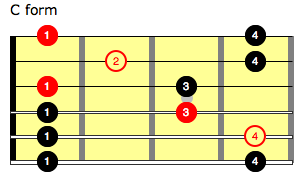It’s easy enough to find any scale for guitar on the internet but, how do you practice them effectively in order to be able make music with them? How do you move them to different keys? It’s not an easy task and honestly it is quite a long journey that never really ends.
The first and most obvious thing to do is learn to play the scale from top to bottom correctly. This is trickier than you think and where many guitarist get it wrong. Lets take a C Major Form Pentatonic Scale (Key of Db) for example:

Most players would start from the lowest note on the Low E string and play to the highest note on the High E string and back. This is like starting a sentence in the middle and reading to the middle of the next sentence. Each scale has a beginning and an end which starts or ends on a Root Note ( The circled notes above). The Major Scale for example has 7 notes or scale degrees: 1 2 3 4 5 6 7. If you played this scale from the lowest note to the highest and back you would be starting and ending on the 3rd degree. As I said, this is like starting and ending in the middle of a sentence and is confusing to how your ear is learning to hear that scale. This is not to say that this is how you should improvise with it. It’s simply how the scale needs to played in the beginning. The 1st scale degree of any scale is home and just like us we always start out and return to home.
Always do the following when practicing any scale:
- Start and End on the lowest Root Note in the scale. It is important for our ear to hear the scale start and end on the Root Note. If we don’t do this we are learning to hear the scale incorrectly and will sound more like one of the 7 Modes.
* The root will often NOT be the lowest note in the pattern. In the above example the lowest root note is the 4th finger on the A string , but the lowest note is actually 1st finger on the low E string.
- Start and end always on either beats 1 or 3. This makes the scale end on a strong beat. This is also where chords most often change making it a good place to practice completing a musical phrase.

*Notice how the 2nd to last note in the example above adds an E note for the purpose of pushing the scale so it ends on beat 1.
- Play all roots at the end. It is important to know where the roots are. They can help you in finding and locating your scale patterns.
- Use a metronome or a drum groove to play along with. Solid rhythm is the most important thing to have as a musician. If you’re making a lot of mistakes slow your tempo down until your accuracy is almost flawless.
- Use alternate strokes. Downs on the downbeats and ups on the off beats.
- Make sure to pay attention the correct fingerings. Playing the scale needs to eventually become muscle memory and this only happens if you use the same fingerings every time. I prefer to use fingering that are closest to the ones I would use when soloing. There are a lots of ways to finger your scales but only a few good ones.
*Learning quickly and efficiently is more about accuracy than speed, so slow down and have patience!!!
 Copyright secured by Digiprove © 2015 jeff lauffer
Copyright secured by Digiprove © 2015 jeff lauffer

awsome information I thought that it would not be easy for me to play any guitar anymore.